~ Identical Twins Heal Body Image Issues Through Fine Art Nudes ~
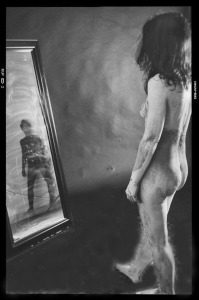
“Sometimes I feel like Peter Pan. But not because I don’t want to grow up. I’m like Peter Pan in that I’m chasing my shadow, only my shadow is my body.” – Lisanne Sartor
When I was 46-years old, I had flattering nudes taken of myself to combat negative feelings I had about my rounder, aging body.
It was so liberating, I wanted to do the same thing for other women.
So last year I conceived the Love Your Body Now: Healing Body Image Issues Through Fine Art Nudes Project.
I brought in gifted, Boulder-based photographer Beth Sanders to shoot our subjects, and body-centered coach Marlene Zaleznick to guide them through the process.
I hoped our project would be an antidote to the barrage of Size-0, photo-shopped models women see in aspirational settings across billboards, television and magazines ad nauseam.
~The Applicants~
When 48-year-old identical twins, Lisanne and Colette Sartor, volunteered to participate in our project I didn’t think they were suitable candidates.
Thus far, we’d shot three full-bodied women who struggled emotionally with their appearance. We thought they best represented the majority of women suffering from body image issues.
Lisanne and Colette didn’t fit that mold. They’ve both maintained svelte, gamine figures, which elicit jealousy from women half their age.
The sisters are also incredibly accomplished. Colette earned a BA in psychology from Yale, then a law degree from Harvard.
When she decided she no longer wanted to be a lawyer, she switched gears and earned an MFA in fiction from the most exclusive literary graduate program worldwide, the Iowa Writers’ Workshop.
Lisanne was no less ambitious, earning her BA in English from Yale; an MFA in screenwriting from UCLA, and finally, acceptance into the exclusive AFI Directing Workshop for Women, which boasts such luminary alums as Maya Angelou and Cicely Tyson.
Why would two such beautiful, successful, accomplished women need us?
When Lisanne and Colette returned our questionnaires I realized my concept of loving our bodies now was still only skin deep. Despite outward appearances, both sisters were dealing with an extraordinary amount of pain.
Lisanne is plagued by chronic illness: gastric ulcer, abscessed Bartholyn gland, precancerous uterine cells, migraines, precancerous polyps, Crohne’s Disease, Intercystial Cystitis, Sacroiliac joint dysfunction, Spondylitis, two bouts of depression and debilitating insomnia.
Colette’s body shadows Lisanne’s.
Her ailments are similar, but less debilitating. Lisanne is the older sister by eight minutes. It’s as if her body has somehow served as a barrier for her sister’s, taking the brunt of the pain.

I wondered whether our project could also serve as a catalyst for healing cellular trauma in our subjects, so they could come back to their bodies and live in them again?
Which meant, more than anything, that loving our bodies now is about coming home.
~Guided Body Work~
Body-coach Marlene sits cross-legged on my couch opposite Lisanne, leading her in a guided meditation. She asks Lisanne to imagine there’s a filament in the center of her womb that is like the filament in a light bulb. Then to imagine that filament ignited, sending light throughout her body, the way a light bulb illuminates a room.
But Lisanne struggles. The Spondylitis (inflammation of the vertebrae) has flared up, stealing her focus.
Marlene asks, “Can you touch the part of your back that hurts?”
Lisanne tentatively obeys, her movements slow, cautious, like the movements of a much older woman.
“What is your back saying?” asks Marlene.
Lisanne closes her eyes, takes a moment to consider. “Busy busy busy,” she says, “Busy like a bee. Whenever I’m afraid, I go to busy and angry.”
“Take a peek at the fear. What’s the fear about?” Marlene asks.
“It’s always the fear of failure.”
“What if you touched your back, as though you loved it?”
“It’s hard to love,” Lisanne says. Then somberly, “I feel like it’s failed me.”

Later, Marlene works with Colette, asking her to have compassion for the parts of her body that aren’t working properly. “What would it feel like,” Marlene softly queries, “to have compassion for your body?”
“Self-indulgent,” Colette asserts unequivocally.
“The men in our family always say, if you want to play with the Big Dogs, you can’t piss like a puppy. Self-compassion is pissing like a puppy.”

~The Third Body~
Lisanne and Colette were raised in New Jersey by Italian-Catholic parents who laughed as hard as they fought. At least in the beginning.
In time, the arguing over-shadowed the laughter, rendering it obsolete.
The defining trauma of the twins’ childhood was their mother’s weight, which sometimes rocketed to almost 400 pounds, and the family’s disappointment in her.
The sisters intuitively knew their morbidly obese mother, who’d given up her own academic studies to marry and have children, was “pissing like a puppy” in their family’s eyes.
From a young age, the twins fought to be the antithesis of their mom and were driven to succeed.
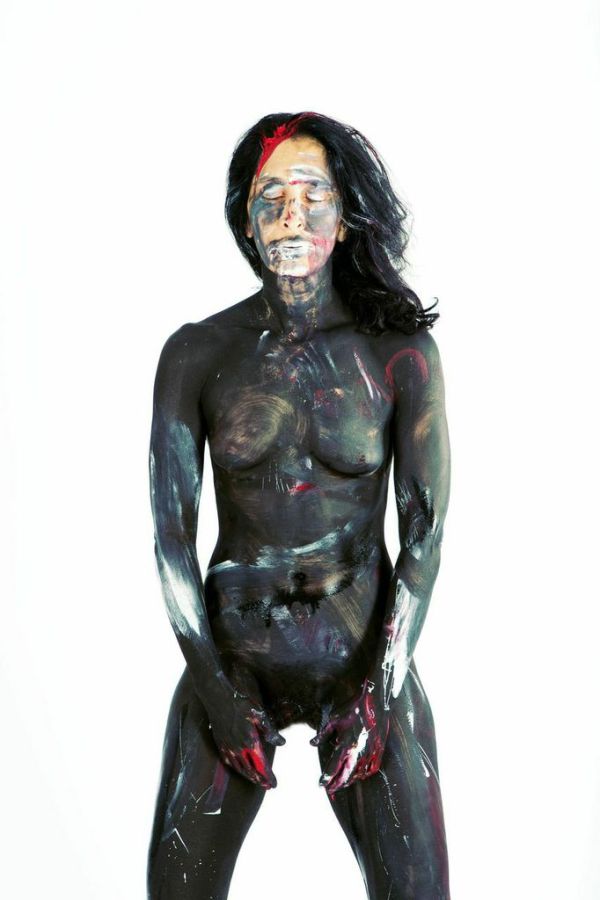
Academically and professionally the sisters were running with the Big Dogs. But it wasn’t enough. They also had to stay thin.
Colette spent much of her 20s and 30s running six miles a day, six days a week. Lisanne took up swimming.
“Never one to do anything half-assed,” she said,” I quickly went from swimming ten laps a day to swimming two miles a day, six days a week.
“I remember toweling off after a workout and someone asking me how many laps I’d swum. When I told her 110, she gasped.
“I’d always prided myself on being thin (don’t be like your mother, don’t be like your mother), as if it were my greatest asset.”
I wondered if some of the sisters’ chronic ailments were exercise-related.
”The chronic illnesses I was first exposed to,” Lisanne wrote, “were my mother’s. Her eating disorder and her depression.”
Lisanne and Colette’s mother died of complications from morbid obesity on April 27, 2013.
Although their mother is gone, the relationship she had with her body still reverberates in the twins’ bodies today.
~The Shoot~
The day after Marlene’s bodywork sessions, our group meets at a rented photographic studio in the Flower Market District of downtown Los Angeles for the shoot.
Colette stands, painted starkly black against a white backdrop. The studio is sweltering, because the air conditioner short-circuits the moment we plug in the lights.
In her body paint, Colette seems more garbed than Beth, Marlene and me. The three of us have stripped down to bra and underwear to withstand the heat and our own menopausal hot flashes. I can’t help thinking it’s fitting that we should also be undressed, thus equally vulnerable.
As Beth begins to shoot Colette, Marlene continues to work with her. She asks Colette to say, I am beautiful.
“Do I have to?” Colette grimaces.
“Yes!” Marlene insists.
“I am beautiful,” Colette says, as if she’s tasted glue.
“When you said that, where did it come from?” Marlene asks.
Colette points to her head. “Up here.”
I’m struck by something. “Maybe it wasn’t okay to be beautiful, when your mother wasn’t?” I query.
Colette and Lisanne both say their mother was stunning when she was young and thin, more beautiful than they are now. But when people first met their mother when she was obese, the sisters often saw shock in their eyes.
After one of Lisanne’s boyfriends met their mom for the first time, he said, “That is your mother?”
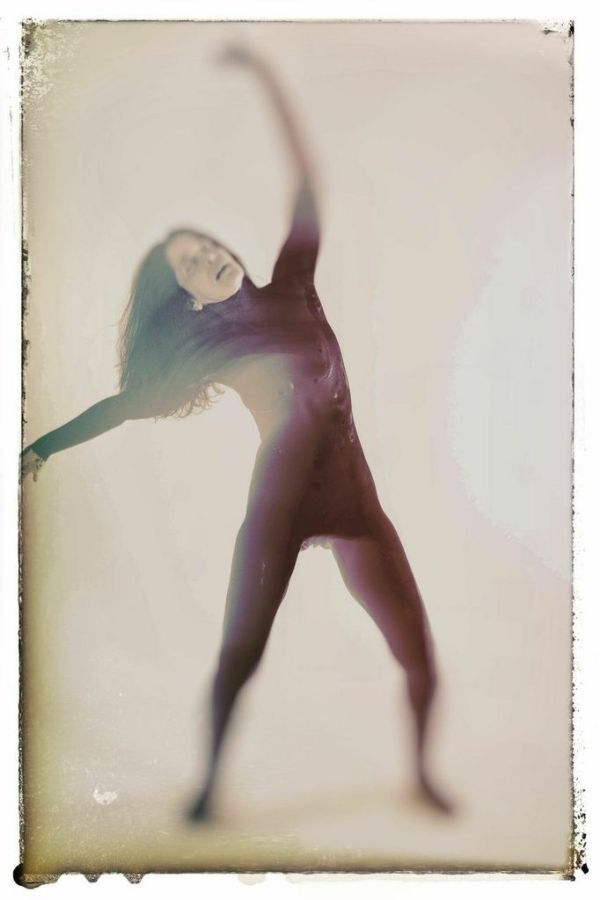
Colette’s face fills with pain. “Once we were older, no one said my mother was beautiful. So we couldn’t be.”
“Let’s come back to your body,” Marlene instructs her.
Colette has difficulty focusing.
“When did you feel most connected to your body?” Marlene asks.
Instantly, Colette’s face lights up. “When I was singing. To sing properly you have to sing from your core.”
Colette indicates the same place in her body that Marlene has been guiding her back to again and again during body meditation; the center of her diaphragm, or what Marlene refers to as her “womb space.”
Colette tells us how much she loved singing, but that she doesn’t do it anymore.
“Why’d you give it up?” Marlene asks.
“I got to a stage in my development as a singer where I knew I couldn’t get any better. And that I just wasn’t good enough, that I couldn’t make a real living at it.”
“You don’t sing anymore at all?” queried Beth.
Colette seems almost shy, as if admitting an embarrassing secret. “I sing to my son when I put him to bed. But, that’s the only time.”
“Look at the pain you’re feeling right now as if it were a small child,” says Marlene. “Embrace it. Sing what wants to come up.”
I worry Colette doesn’t want to sing, that we’re asking too much.
“What lullaby would come up, if you were to sing to a child?”
Colette opens her mouth, and from the base of some primal well her voice emerges in a wordless lullaby. My arms are covered in gooseflesh as Beth’s shutter snaps away. Colette’s voice is lush, gorgeous and, I can’t help thinking, this song is an elegy to the mother who haunts her still.
When the song ends Colette’s session changes. It becomes a bit rebellious, even playful.
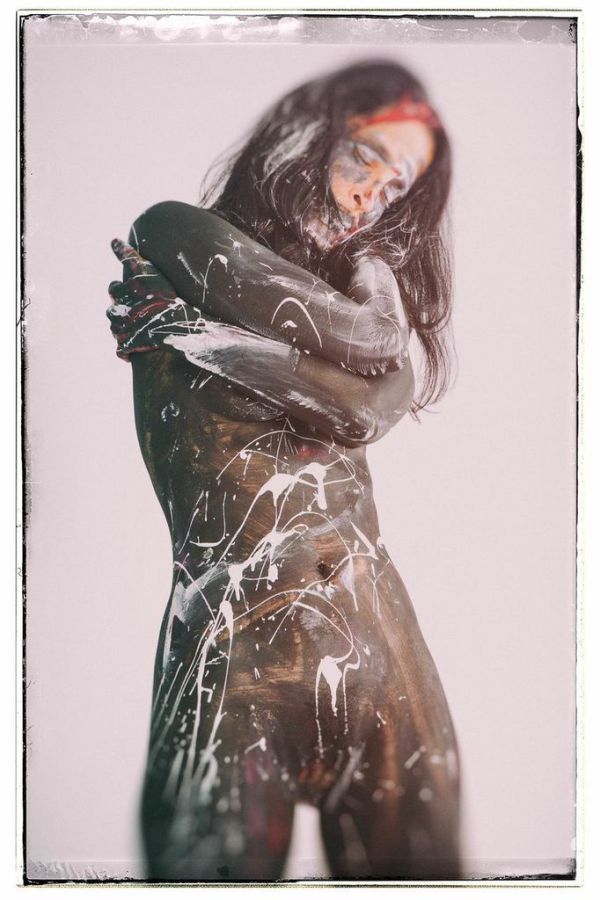
Beth instructs her to paint her own body any way she pleases.
Colette splashes the canvas of her body with paint, laughing like a young girl.
It strikes me that she appears to be both Jackson Pollock and one of his works of art.
Colette tells us she and her sister weren’t the kinds of kids who got messy.
“We took our clothes off to play in the sand box. We didn’t want to get our clothes dirty.”
Marlene asks, “If you could talk to each line made with your paint brush, what would you say?”
“It’s okay to just be. I can do whatever I want. I don’t have to be a good girl.”
~Exquisite Sensitivity~
Lisanne, her nude body painted completely white, with thin lines of red paint demarking all the places that pain her, stands against the black paper backdrop, stiff, guarded, as if girding herself for an invasion.
Lisanne was surprised Beth wanted to paint her white.
She jokingly said she’s the darker of the sisters, so she should be the one painted black.
Lisanne is still angry that her parents often treated her like an adult, confiding things they shouldn’t have to a child and sometimes even using her as a mediator between them.
It’s this anger that makes her seem tougher and stronger than Colette.
But Beth sensed Lisanne’s “exquisite sensitivity” and sadness, which she thought the white paint might bring out.
As Beth begins shooting Lisanne, her back spasms and begins to throb. We’d learned during Marlene’s workshops that the more Lisanne runs from her fear of failure, the more she abandons her body. And, in turn, the more her body fails her.
“I was always afraid of doing a bad job, of being a failure, of not being able to hold my own with the Big Dogs. So afraid that I sacrificed my health and happiness,” says Lisanne.
Beth instructs her to move into poses that relieve the pain in her back.
I’m struck by the beauty of her poses, how they seem to evoke grief, anger and letting go:
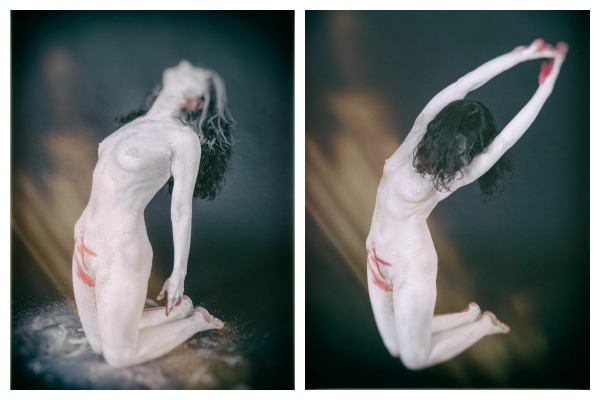
When the sessions end, four hours later, all of us are simultaneously exhilarated and spent.
~ Presenting The Photos ~
Two days later Beth, Marlene and I meet with the sisters for the last time to present their photos to them. They both revel in the artistry and emotion of the images. I wonder how that might unspool over time.
Marlene asks the sisters to check in with their bodies, to come into a meditative state. She asks if they can think, for a moment, about their mother and how they didn’t feel they could be beautiful, because no one told their mom she was beautiful.
“Could you think that when you are beautiful it is for your deceased mother? That you are honoring and healing the lineage of body hatred and shame for her?”
Both women have such mixed emotions about their mom. Love. Loyalty. Fierce protectiveness. Sadness. Anger. Regret.
Lisanne writes beautifully about the time she realized her mom was more than just her mother, but a person in her own right.
“I wore my mom’s wedding dress when I got married. One day, my mom and I were talking about my wedding video, which we’d gotten recently and which my mom had just watched.
“She told me that during the father-daughter dance, she’d gotten confused and wondered where in the hell I was, and why she was dancing with my dad? And then she realized it was me, not her, dancing with my dad in her wedding dress.
“She cried as she told me, and I realized for the first time in my whole life that when my obese mother looked in the mirror, she still saw the thin woman she’d been when she got married. Or the vestiges of that woman. And missed her.”
The story of these three bodies doesn’t end here.
It’s the journey of a lifetime. But my hope for Lisanne and Colette is that more and more often they will love and inhabit their bodies.
That more frequently than not, it will be possible to come home.
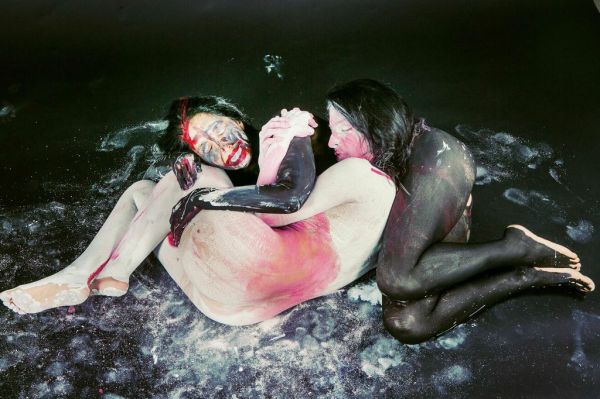

11 thoughts on “Three Bodies”
Wow. This is stunning. I am very thankful that I read this post, sister. Very moving and gorgeous.
Michelle thanks for stopping by. Off to read you too!
What an amazing story and incredible project, Shannon. This will be life-changing for so many women.
Thanks so much Lois — I love Beth’s photography so much, she’s such a gifted, intuitive, loving artist.
Agreed, I’m very glad I read this post as it was very thought provoking and the images are gorgeous as well. Also interesting, was the that initially the twins were seen as not fitting in as svelte persons; yet they to suffered incredible body issues.
Hi Bodynsoil– it’s interesting how people who look the way we all want to look still have their own struggles.
As a writer, I have no words. I loved everything about this post. I’m touched.
Andee thanks so much That means a lot.
This is an incredible project, Shannon, and caught my interest because my two best friends for 45 years are identical twins. They are gorgeous, tall, blonde and I love them dearly like sisters.
But growing up was difficult for me when walking into a crowded room with them when you’re the one with curly hair, a big Jewish nose AND glasses was, well, you can imagine. Guys talked to them only. But that’s another story for a blog post….
This was fascinating and I am glad you wrote about it. Marvelous. xoxo
Hi Cathy — there is something so beautiful and fascinating about twins. When I’m with Lisanne and Colette together I feel touched by magic.
You are spreading more than art; you are spreading hope.
Comments are closed.